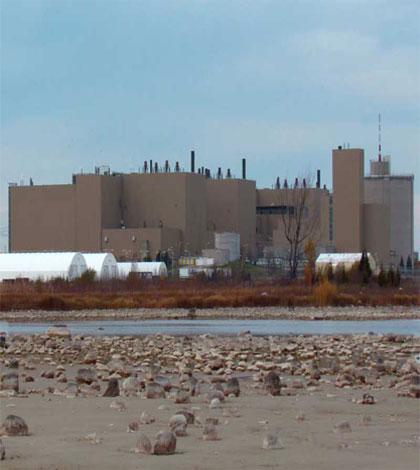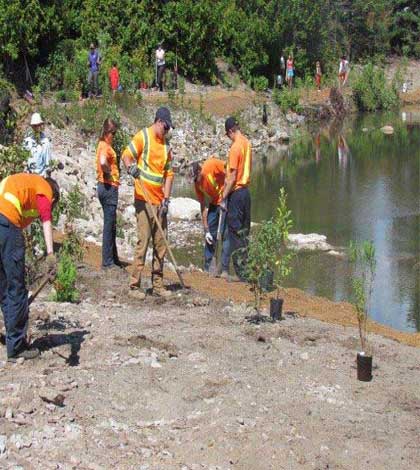KINCARDINE—Two Manitoulin residents are among the long list of speakers at the joint review panel in consideration of Ontario Power Generation’s (OPG) proposed deep geological repository for low and intermediate level radioactive waste in southern Ontario over the past few weeks, and they have made their feelings known strongly they are against this proposal.
“I know one thing I said is that at the Seaborn hearing panel dealing with a proposal for burying high level nuclear waste on the North Shore in the mid-1990s, a lot of time and presentations were made at that hearing” said Ed Burt of Kagawong. “One of the recommendations that was made at that hearing was to set up a Nuclear Waste Energy committee panel made up of impartial people with no one that had any involvement in nuclear waste at all. But they did the opposite, they formed the Nuclear Waste Agency and most are from the industry, which I said was a classic example of having the fox look after the chicken coop.”
Mr. Burt explained, “In the 1960s there were not many options for energy, we had coal, nuclear and hydraulics. I said now we are 15 years behind in wind technology from other countries such as Germany. We do have wind energy on Manitoulin and it won’t take long in producing four to five times more than is needed, and we have the soil and hydraulics in place here. What we need to do everywhere is to stop hiring nuclear engineers.”
Mr. Burt told the Recorder, “One of the things I told the panel is that one of the main reasons I wanted to speak at the hearing is that I believe in karma. I don’t want to be responsible for that repository being part of our legacy. At least now I will be able to look back and say I made my case, when we will all probably have a hell of a price.”
Mr. Burt is one of the many speakers at the hearings looking into the proposed Ontario Power Generation nuclear waste facility. The hearings are taking place over a four-week period, and began the third week of September in Kincardine. OPG plans to bury 200,000 cubic metres of low and intermediate nuclear waste 680 metres underground. If approved, the facility would be within 1.5 kilometres of Lake Huron. Engineers, geologists, residents, politicians and Native groups have all spoke at the hearings.
Mike Wilton of Spring Bay also presented his concerns at the hearings. “On or about August 12, 2013 I forwarded notes containing questions with regard to factual information concerning the proposed burial of low-level nuclear waste beneath the Bruce nuclear facility. Since I have received no response to my questions, I will elaborate here upon my major concerns.”
“Called a deep geological repository, the burial caverns (below Bruce Nuclear) would be 680 metres (2,230 feet) below the earth’s surface, approximately 650 metres (2,130 feet) inshore from Lake Huron,” Mr. Wilton told the panel. “The wastes would be placed in caverns carved out of the limestone rock. This would place the caverns well below the surface of Lake Huron.”
“Limestone is always created in layers, which then fracture as the earth’s crust shifts,” explained Mr. Wilton. “Granite is subject to pressure cracks and shifts as well. Therefore, since water always seeks its own level, there will be a tendency for groundwater to seep or flow into the caverns. It will be virtually impossible to permanently (1,000 years) waterproof the caverns against the downward pressure exerted by the extreme depth below the water table.”
“The need to pump inflowing water from the caverns is inevitable,” said Mr. Wilton. “Deep mining, e.g. the Adams Mine near Kirkland Lake and the Helen Mine at Wawa, are proof of this fact. What provisions have been made to deal with inflowing groundwater at the Bruce Nuclear site?”
“The Providence Bay landfill, situated over fractured limestone on the Manitoulin Island, which is also part of the Niagara Escarpment, provides an excellent example of the need to fully understand groundwater, as follows: the groundwater plume passes through and beneath the Providence Bay dumpsite in a westerly direction, at the rate of between 0.8 metres per year and 8.3 metres per year, directed towards Lake Huron,” he explained, reading from a report from Waters Environmental Geosciences Ltd. 2009. “That plume carries (and will continue to carry for an indeterminate period) dissolved chemicals, metals and solids into the waters of Providence Bay, Lake Huron.”
Mr. Wilton reasoned, “The only safe solution (which carries its own set of problems) is to store the wastes at Bruce Nuclear above ground, thus reducing exterior pressure, where leakage can be adequately monitored and subsequently dealt with. The task facing OPG will then be to ensure that no leakage from the above-ground containment facility takes place, but at least it will be possible to identify and swiftly act upon problems if and as they occur.”
“I also had the chance to tell the panel there is a nuclear reactor in Douglas Point and years ago there were plans to build a reactor plant at Swift Current, just off the east end of Manitoulin. Every time I’m going by the clear rock at Swift Current I stop and say a prayer that the reactor was never built,” said Mr. Burt.
“Ontario Power Generation’s proposed deep geologic repository for low and intermediate level radioactive waste beneath the Bruce nuclear site at Kincardine is a concern for me and for other residents of Manitoulin Island and the North Channel and North Shore of Lake Huron,” said Mr. Burt. “I am concerned that the repository may result in the release of radionuclides into Lake Huron, either as a result of an accident or because the repository does not contain the water for the long period of time for which it is radioactive.”
“There are already too many nuclear activities at the Bruce Nuclear site and too many nuclear installations around Lake Huron, including those that I have talked about on the North Shore of Lake Huron. Singly or in combination they can cause great harm to the lake and the environment around it,” continued Mr. Burt.
“As the deadline for submitting this statement approached, I was thinking about how to express my concerns to the panel and about how to convey all that I have observed in the many years of being involved in nuclear issues in the Lake Huron region,” continued Mr. Burt. “I was reading the July/August issue of National Geographic and found the article about stresses around the Great Lakes to be a visual representation of the concerns that I feel. These concerns increased when I consider the prospect of deep geological repository for nuclear waste being built at the Bruce site.”
“From Hiroshima to Fukushima we have all been subject to the experiments of the nuclear industry, although some have suffered more than others,” continued Mr. Burt. “The proposed deep geological repository is another dangerous experiment. It should not be allowed to be built.”




